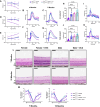This is a preprint.
Female sex hormones exacerbate retinal neurodegeneration
- PMID: 39071341
- PMCID: PMC11275730
- DOI: 10.1101/2024.07.11.603104
Female sex hormones exacerbate retinal neurodegeneration
Update in
-
Female sex hormones exacerbate retinal neurodegeneration.Sci Adv. 2025 Apr 11;11(15):eadr6211. doi: 10.1126/sciadv.adr6211. Epub 2025 Apr 11. Sci Adv. 2025. PMID: 40215317 Free PMC article.
Abstract
Neurodegenerative disorders such as Alzheimer's disease and macular degeneration represent major sources of human suffering, yet the factors influencing disease severity remain poorly understood. Sex has been implicated as one potential modifying factor. Here, we show that female sex is a risk factor for worsened outcomes in a model of retinal degeneration. Further, we show that this susceptibility is caused by the presence of female-specific circulating sex hormones. The adverse effect of female sex hormones was specific to diseased retinal neurons, and depletion of these hormones ameliorated this phenotypic effect. These findings provide novel insights into the pathogenesis of neurogenerative diseases and how sex hormones can impact the severity of disease. These findings have far-reaching implications for clinical trial design and the use of hormonal therapy in females with certain neurogenerative disorders.
Conflict of interest statement
Competing interests: Authors declare that they have no competing interests.
Figures





References
-
- Marin A. I., Poppelaars F., Wagner B. D., Palestine A. G., Patnaik J. L., Holers V. M., Frazer-Abel A. A., Mathias M. T., Manoharan N., Fonteh C. N., Mandava N., Lynch A. M., Sex and Age-Related Differences in Complement Factors Among Patients With Intermediate Age-Related Macular Degeneration. Trans. Vis. Sci. Technol. 11, 22–22 (2022). - PMC - PubMed
-
- Sasaki M., Harada S., Kawasaki Y., Watanabe M., Ito H., Tanaka H., Takeuchi A., Tsubota K., Takebayashi T., Nishiwaki Y., Kawasaki R., Gender-specific association of early age-related macular degeneration with systemic and genetic factors in a Japanese population. Sci. Rep. 8, 785 (2018). - PMC - PubMed
Publication types
Grants and funding
LinkOut - more resources
Full Text Sources
